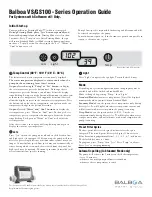
OPERATION
Appliance description
www.stiebel-eltron.com
WPL ACS classic |
5
3. Appliance description
3.1 Minimum software versions
The following minimum software versions are required for oper-
ating the heat pump:
- WPM: 390.09
- MFG: V.14
- FES: 417.05
3.2 Operational characteristics
The appliance is an air | water heat pump that operates as a heat-
ing heat pump for outdoor installation. Heat is extracted from the
outdoor air at a low temperature level, and is then transferred to
the heating water at a higher temperature. The heating water can
be heated up to a flow temperature of 60 °C.
This appliance has further operational characteristics:
- Suitable for underfloor heating systems.
- Preferred for low temperature heating systems.
- Extracts heat from the outdoor air even at outside tempera-
tures of -20 °C.
- Corrosion-protected, external casing made from hot-dipped
galvanised sheet steel plus stove-enamelled finish.
- Filled with non-combustible safety refrigerant.
Note
The appliance may only be used in conjunction with the
following products:
- Hydraulic module HM(S) (Trend) (BE)
- Cylinder and hydraulic module HSBB 200 (S) clas-
sic (BE)
- Integral cylinder HSBC 200 (S) (BE)
3.3 Function
3.3.1 Heating
Heat is extracted from the outdoor air via the heat exchanger
(evaporator) on the air side. The evaporated refrigerant is com-
pressed by a compressor. This process requires electrical ener-
gy. At this point, the refrigerant is at a higher temperature level.
A further heat exchanger (condenser) transfers the heat to the
heating circuit. The refrigerant then expands again and the cycle
restarts from the beginning.
At air temperatures below approx. 7 °C, the humidity in the air
condenses as hoarfrost on the evaporator fins. Any hoarfrost is
automatically defrosted. The resulting water flows out of the ap-
pliance via the free condensate drain and seeps away into the
gravel bed.
!
Material losses
In the defrost cycle, the fan is switched off and the heat
pump circuit is reversed. The heat required for defrosting
is drawn from the buffer cylinder. For operation without a
buffer cylinder, observe chapter "Operation / Menu struc-
ture / Menu SETTINGS / STANDARD SETTING / BUFFER
OPERATION" in the operating and installation instructions
of the WPM. Otherwise the heating water freezes under
unfavourable conditions.
Note
In winter, icicles can form on the bottom of the conden-
sate drain. This does not interfere with the operation
of the appliance, provided the condensate can drain off
unimpeded.
The heat pump automatically reverts to heating mode at the end
of the defrost cycle.
!
Material losses
In dual mode operation, return water from the second
heat source may flow through the heat pump. Please note
that the return temperature must be no higher than 60 °C.
3.3.2 Cooling
!
Material losses
The heat pump is not suitable for continuous, year-round
cooling.
f
f
Observe the application limits (see chapter "Specifi-
cation / Data table").
Note
The HM(S) (Trend) (BE) is equipped for both area and
fan cooling.
The HSBB 200 (S) classic (BE) and HSBC 200 (S) (BE) can
provide area cooling.
Rooms are cooled by reversing the heat pump circuit. Heat is
extracted from the heating water. The evaporator transfers this
heat to the outdoor air.
Area cooling requires the installation of the FEK remote control
unit in a reference room to capture the relative humidity and the
room temperature as part of dew point monitoring.
Fan cooling requires the installation of the FE7 remote control
unit in a reference room to capture the relative humidity and the
room temperature as part of dew point monitoring. Similarly, it
is necessary to install a buffer cylinder.
Heat pump application limit
The heat pump is switched off if the outside temperature falls
below the selected lower application limit for cooling (LIMIT COOL-
ING parameter).






































